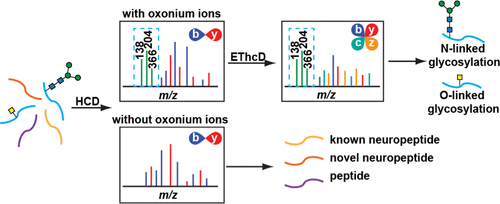当前位置:
X-MOL 学术
›
J. Proteome Res.
›
论文详情
Our official English website, www.x-mol.net, welcomes your feedback! (Note: you will need to create a separate account there.)
Signature-Ion-Triggered Mass Spectrometry Approach Enabled Discovery of N- and O-Linked Glycosylated Neuropeptides in the Crustacean Nervous System.
Journal of Proteome Research ( IF 4.4 ) Pub Date : 2020-01-13 , DOI: 10.1021/acs.jproteome.9b00525 Qinjingwen Cao 1 , Qing Yu 2 , Yang Liu 1 , Zhengwei Chen 1 , Lingjun Li 1, 2
Journal of Proteome Research ( IF 4.4 ) Pub Date : 2020-01-13 , DOI: 10.1021/acs.jproteome.9b00525 Qinjingwen Cao 1 , Qing Yu 2 , Yang Liu 1 , Zhengwei Chen 1 , Lingjun Li 1, 2
Affiliation

|
Crustaceans are commonly used model organisms to study neuromodulation. Despite numerous reported crustacean neuropeptide families and their functions, there has been no report on neuropeptide glycosylation. This is in part due to a lack of sensitive methods that enable deciphering this intricate low-abundance post-translational modification, even though glycosylation has been shown to play an important role in neuromodulation. Here, we describe the discovery of glycosylated neuropeptides with an enrichment-free approach, taking advantage of signature oxonium ions produced in higher-energy collision dissociation (HCD) MS/MS spectra. The detection of the oxonium ions in the HCD scans suggests glycan attachment to peptides, allowing electron-transfer/higher-energy collision dissociation (EThcD) to be performed to selectively elucidate structural information of glycosylated neuropeptides that are buried in nonglycosylated peptides. Overall, 4 N-linked and 14 O-linked glycosylated neuropeptides have been identified for the first time in the crustacean nervous system. In addition, 91 novel putative neuropeptides have been discovered based on the collected HCD scans. This hybrid approach, coupling a shotgun method for neuropeptide discovery and targeted strategy for glycosylation characterization, enables the first report on glycosylated neuropeptides in crustaceans and the discovery of additional neuropeptides simultaneously. The elucidation of novel glycosylated neuropeptides sheds light on the crustacean peptidome and offers novel insights into future neuropeptide functional studies.
中文翻译:

签名离子触发质谱方法可在甲壳动物神经系统中发现N和O联糖基化神经肽。
甲壳类是常用的模型生物来研究神经调节。尽管已报道了许多甲壳类神经肽家族及其功能,但尚未有关于神经肽糖基化的报道。这部分是由于缺乏灵敏的方法来解密这种复杂的低丰度翻译后修饰,即使已显示糖基化在神经调节中起着重要的作用。在这里,我们描述了一种无浓缩方法的糖基化神经肽的发现,该方法利用了在高能碰撞解离(HCD)MS / MS光谱中产生的特征性氧鎓离子。在HCD扫描中检测到的氧离子表明,聚糖附着在肽上,允许进行电子转移/高能碰撞解离(EThcD),以选择性阐明埋在非糖基化肽中的糖基化神经肽的结构信息。总体而言,在甲壳类神经系统中首次鉴定出4个N-连接和14 O-连接的糖基化神经肽。此外,基于收集的HCD扫描发现了91种新型推定神经肽。这种混合方法,结合了用于神经肽发现的shot弹枪方法和用于糖基化表征的靶向策略,能够首次报道甲壳类动物中糖基化神经肽并同时发现其他神经肽。
更新日期:2020-01-14
中文翻译:

签名离子触发质谱方法可在甲壳动物神经系统中发现N和O联糖基化神经肽。
甲壳类是常用的模型生物来研究神经调节。尽管已报道了许多甲壳类神经肽家族及其功能,但尚未有关于神经肽糖基化的报道。这部分是由于缺乏灵敏的方法来解密这种复杂的低丰度翻译后修饰,即使已显示糖基化在神经调节中起着重要的作用。在这里,我们描述了一种无浓缩方法的糖基化神经肽的发现,该方法利用了在高能碰撞解离(HCD)MS / MS光谱中产生的特征性氧鎓离子。在HCD扫描中检测到的氧离子表明,聚糖附着在肽上,允许进行电子转移/高能碰撞解离(EThcD),以选择性阐明埋在非糖基化肽中的糖基化神经肽的结构信息。总体而言,在甲壳类神经系统中首次鉴定出4个N-连接和14 O-连接的糖基化神经肽。此外,基于收集的HCD扫描发现了91种新型推定神经肽。这种混合方法,结合了用于神经肽发现的shot弹枪方法和用于糖基化表征的靶向策略,能够首次报道甲壳类动物中糖基化神经肽并同时发现其他神经肽。

























 京公网安备 11010802027423号
京公网安备 11010802027423号